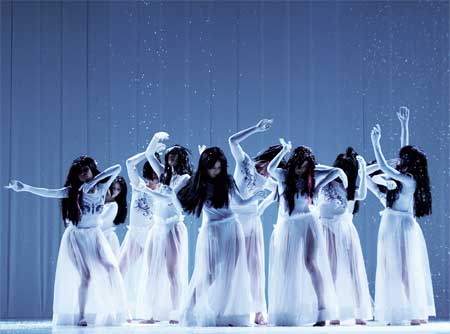Modern dance goes mainstream
Modern dance production Shi Fang (Ten Directions), a celebration of life and the philosophy of Chinese culture, will take to the stage of the Great Hall of the People Friday evening for the second of only two performances at the venue, promising a cultural and visual treat for fans of modern dance.
 |
|
Dancers on stage in Shi Fang. [Global Times] |
"Shi Fang or Ten Directions is a Buddhist term indicating the spatial directions of east, southeast, south, southwest, west, northwest, north, northeast, the nadir and the zenith," director Xu Fei told the Global Times. "We want to explore the vastness of the universe, the infinity of space and the endless circulation of life through this work.
"The idea of 10 directions can also indicate the concept of time, which is represented by the growth of life, or the four seasons of a year and reincarnation," added Willy Tsao, choreographer and artistic director of Beijing LDTX Modern Dance Company, while rehearsing with his dancers on the dimly-lit stage, their arms tattooed with ancient Chinese totems, circling in time with mesmerizing music.
"Why do we use modern dance to express such an abstract theme? I think it's because without vocal expression, modern dance can provide viewers a vast room of imagination," Tsao told the Global Times. "The Chinese audience may not be accustomed to modern dance yet, but it's not an excuse as to why we don't do it."
As the founder of three of China's top modern dance companies in Beijing, Guangdong and Hong Kong, Tsao is known as the father of modern dance in China and while still modest in nature, he is credited with bringing the contemporary art form to China.
Although taking inspiration from foreign modern dance masters such as William Forsythe and Pina Bausch in his early stages, Tsao said that his choreography is intrinsically Chinese.
In Shi Fang, Tsao deconstructs traditional Chinese elements, wrapping them up in modern dynamism.
"For example, in the preface of the play, titled In Search of the Beginning, we want to present the state of the universe before the human race comes into being. So when actors appear on the stage, they take the form of tai chi, to indicate the slowness and peace when the world is at its origin."
"In the next chapter Spring, we want to express the growth of life, including love, which is the basis of all human emotions. You can even feel the lust and desire between the male and female dancers which is part of human relations," Tsao added.
"Summer represents the cultural and philosophical dimension because to remain comfortable in a hot summer, one has to be calm and peaceful mentally," he explained. "Therefore, we demonstrate this cultural dimension through the guqin (a seven-string Chinese zither) which is played by a professional performer and Chinese ink painting, delivered by the dancers on the stage."
 0
0 







Go to Forum >>0 Comments